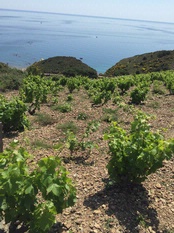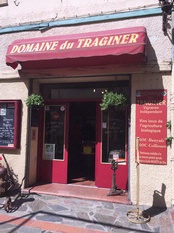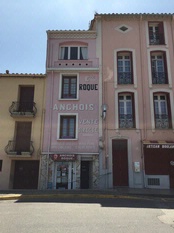|
|
 |

If you aren’t familiar with the wines of Collioure, don’t feel bad--few American wine lovers know anything about this enchanting little sliver of earthly paradise. One reason for its anonymity is that the wine production of Collioure and Banyuls (the two appellations cover the same ground) is relatively small. Another reason is that Collioure is somewhat off the beaten track, carved into the rocky shore of the Mediterranean Sea near the Spanish border (this is Catalan country, with France’s section of the Catalan coastline called the Côte Vermeille, while Spain’s is known as the Costa Brava). Collioure is a tiny, but picturesque, fishing port once known more for its anchovies than its wines. And yet, Collioure is one of France’s most historic wine regions, dating back at least seventeen centuries or so,  when the Phoenicians established a trading port here, and while they were at it they also planted vines. These early invaders were followed by the ancient Greeks and later by the Romans, Visigoths and Arabs. when the Phoenicians established a trading port here, and while they were at it they also planted vines. These early invaders were followed by the ancient Greeks and later by the Romans, Visigoths and Arabs.
Collioure underwent another kind of invasion in the early twentieth century when artists discovered the place. Attracted by the region’s purity of light and color, Matisse, Chagall, Derain, Charles Renee Macintosh and Picasso all spent time in the region. Matisse would return to Collioure many times between 1905 and 1914 to “make the colors sing,” as he said (he declared Collioure’s skies to be “the bluest blue” in the world).
But painters weren’t the only artists who were drawn to this luminous corner of France. Pablo Casals, in exile from Spain during Franco’s regime, lived and worked in nearby Prades (you can go online and watch a grainy but extraordinarily moving video of Casals performing a Bach cello solo in the neighboring Abbey of St. Michel de Cuxa).
Collioure can claim another celebrated artist, the writer Patrick O’Brian. Known for his Aubrey-Maturin series of novels set in the Royal Navy during the Napoleonic Wars, O’Brian lived in Collioure for fifty years, until his death in 2000, and he is buried there. During his time in Collioure O’Brian also developed an interest in wine, going so far as to indulge in a bit of home winemaking using grapes from the small vineyard behind his house.
One other invading force that deserves mention here is the Knights Templar, an order of soldier-monks that arrived in Collioure in the 18th century. What makes them of particular interest to me, and perhaps will to  you as well, is that they set to work restoring those centuries-old vineyards that had originally been planted by the Phoenicians. Among the Knights’ many important viticultural contributions was the establishment of water control systems. Rain is not frequent around here, but when it does arrive, it can be fierce and destructive, washing away the soil in these steep hillside vineyards. The Knights built some 6000 kilometers of stonewall terracing (almost 4000 miles) to shore up the vineyards, and they installed a network of canals to control water flow. They also “invented” the sweet wines of Banyuls by introducing the system of mutage, which stops a wine’s alcoholic fermentation by adding distilled alcohol to a wine in order to conserve part of its natural sugars. I hope you’ve had a chance to read Paul Lukacs’ recent column about the contemporary wines of Banyuls and Collioure here on Wine Review Online. you as well, is that they set to work restoring those centuries-old vineyards that had originally been planted by the Phoenicians. Among the Knights’ many important viticultural contributions was the establishment of water control systems. Rain is not frequent around here, but when it does arrive, it can be fierce and destructive, washing away the soil in these steep hillside vineyards. The Knights built some 6000 kilometers of stonewall terracing (almost 4000 miles) to shore up the vineyards, and they installed a network of canals to control water flow. They also “invented” the sweet wines of Banyuls by introducing the system of mutage, which stops a wine’s alcoholic fermentation by adding distilled alcohol to a wine in order to conserve part of its natural sugars. I hope you’ve had a chance to read Paul Lukacs’ recent column about the contemporary wines of Banyuls and Collioure here on Wine Review Online.
But let’s get back to those anchovies I mentioned earlier. The art of salting fish was brought to Catalonia by the ancient Greeks and refined into a pescatory art form in Collioure. From the Middle Ages until well into the twentieth century, Collioure was the world capital of fine anchovy production. Dozens of salting houses dotted the town, and its fleet of colorful wooden fishing boats bobbed in the port’s azure waters. Today, because of the diminishing catch, Colliour’s fishing industry is moribund. Only a couple of fishing boats remain in the harbor, and only two anchovy  processors have survived (Roque and Declaux--you can visit them for an up-close and personal view of anchovy production). Morocco is now the world’s largest supplier of canned anchovies, although gastronomes agree that Collioure’s are much tastier. processors have survived (Roque and Declaux--you can visit them for an up-close and personal view of anchovy production). Morocco is now the world’s largest supplier of canned anchovies, although gastronomes agree that Collioure’s are much tastier.
In cafés and restaurants up and down the Côte Vermeil and the Costa Brava you can taste wonderful boquerones (pickled fresh anchovies), and the more piquant variation of anchovies preserved in salt and oil. Pungent, savory and loaded with umami, it’s no wonder that anchovies have been part of our diet for lo these many centuries. From garum, the beloved fermented fish sauce of ancient Rome, to Britain’s famed Worcester Sauce (yep, it’s the presence of anchovies that gives that condiment its special kick), to our own infatuation with anchovy-spiked palate pleasers such as Caesar Salad and Bloody Marys, we’ve had a love affair with anchovies for most of our culinary history.
Hungry yet? Here’s a very tasty way to add some anchovy zip to pork pan-seared chops.
Pork Chops with Anchovy Butter
Serves 4
For the anchovy butter:
1 2-ounce can anchovies packed in olive oil
2 tablespoons softened butter
1 tablespoon finely minced parsley
1 garlic clove, finely minced
Drain the anchovies and mash them into a rough paste with a mortar and pestle, or you can use a fork for a chunkier effect. Blend in the remaining ingredients (the mixture does not have to be completely smooth). Refrigerate until ready to use.
For the pork chops:
8 small, boneless thin pork chops
salt and pepper
1 tablespoon butter
Pound each pork chop until it is about ¼ inch thick. Salt and pepper them on both sides. Place the tablespoon of butter in a heavy skillet (cast iron is perfect). Raise the heat and when the pan is hot and the butter foams, add the pork chops (do not let them overlap). Working in batches if necessary, sear the pork chops, then flip them over and sear the other side (this should take only a minute or two per side). Arrange a pork chop in the center of a serving plate, place a quarter of the anchovy mixture in the center of each chop, then top them with the remaining pork chops. Voila: Pork and anchovy sandwiches!
|
 |
|